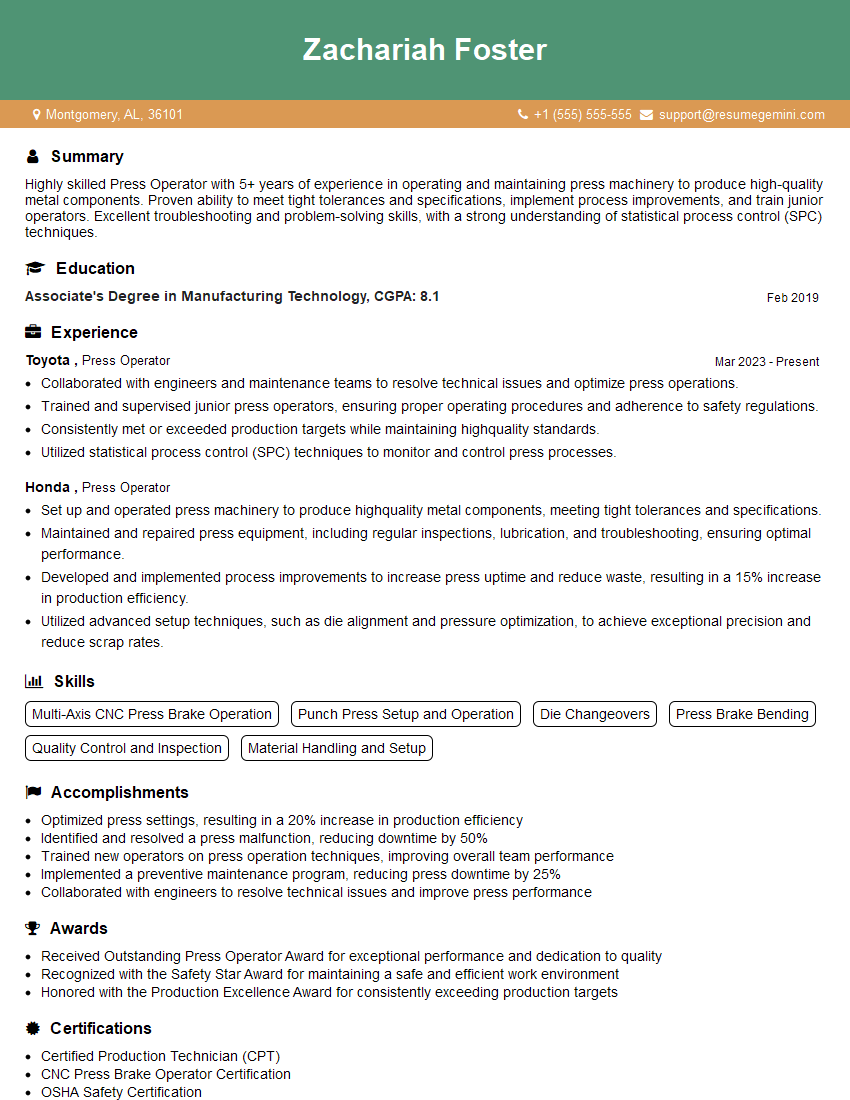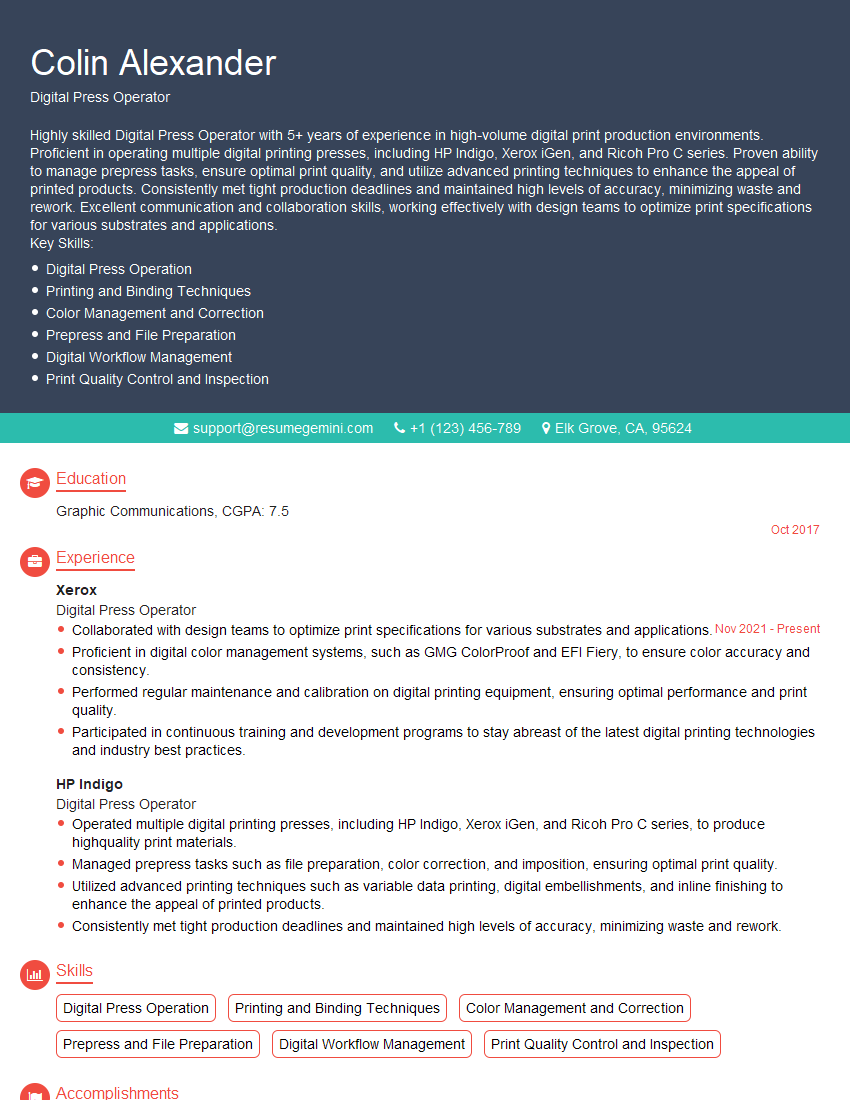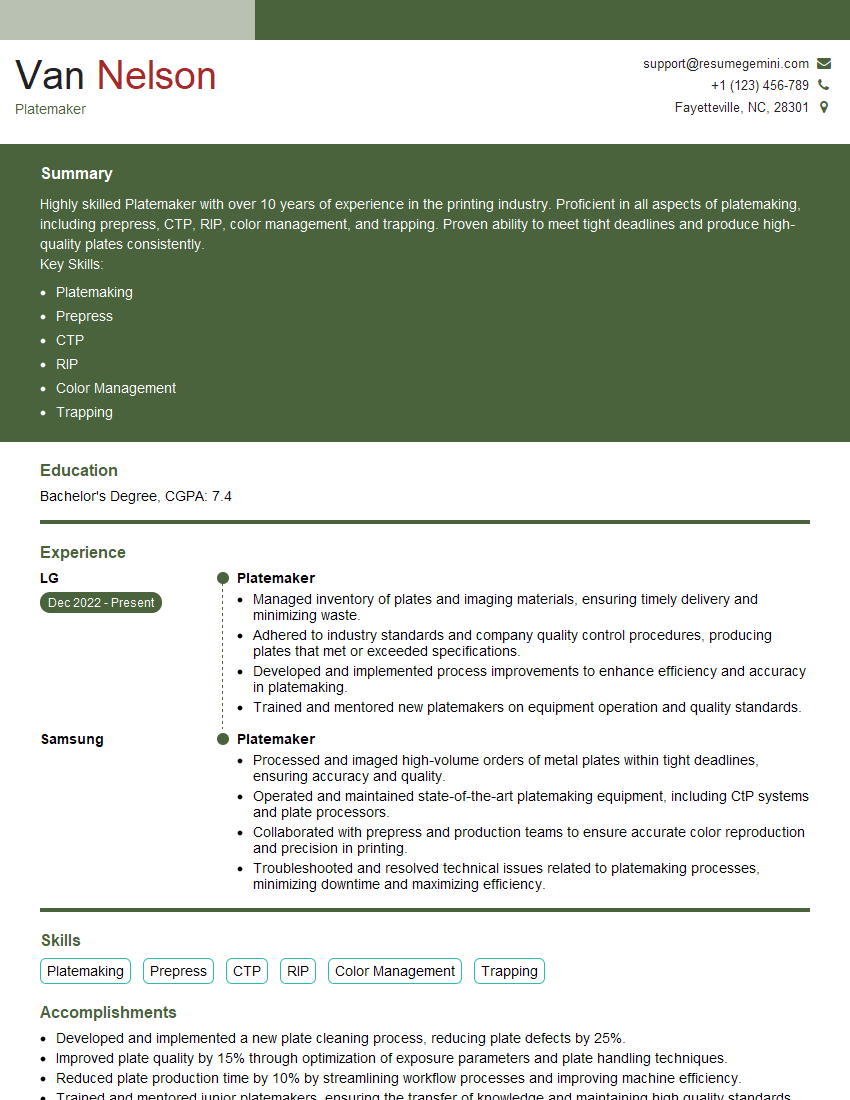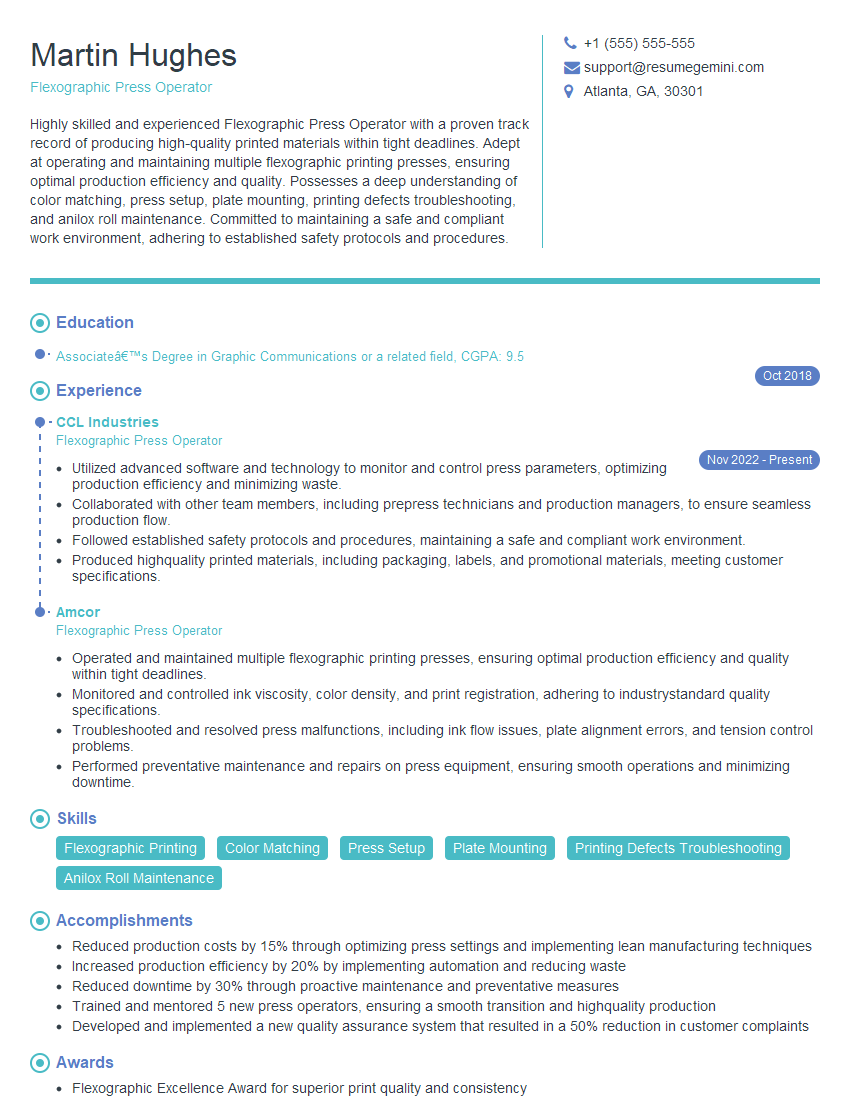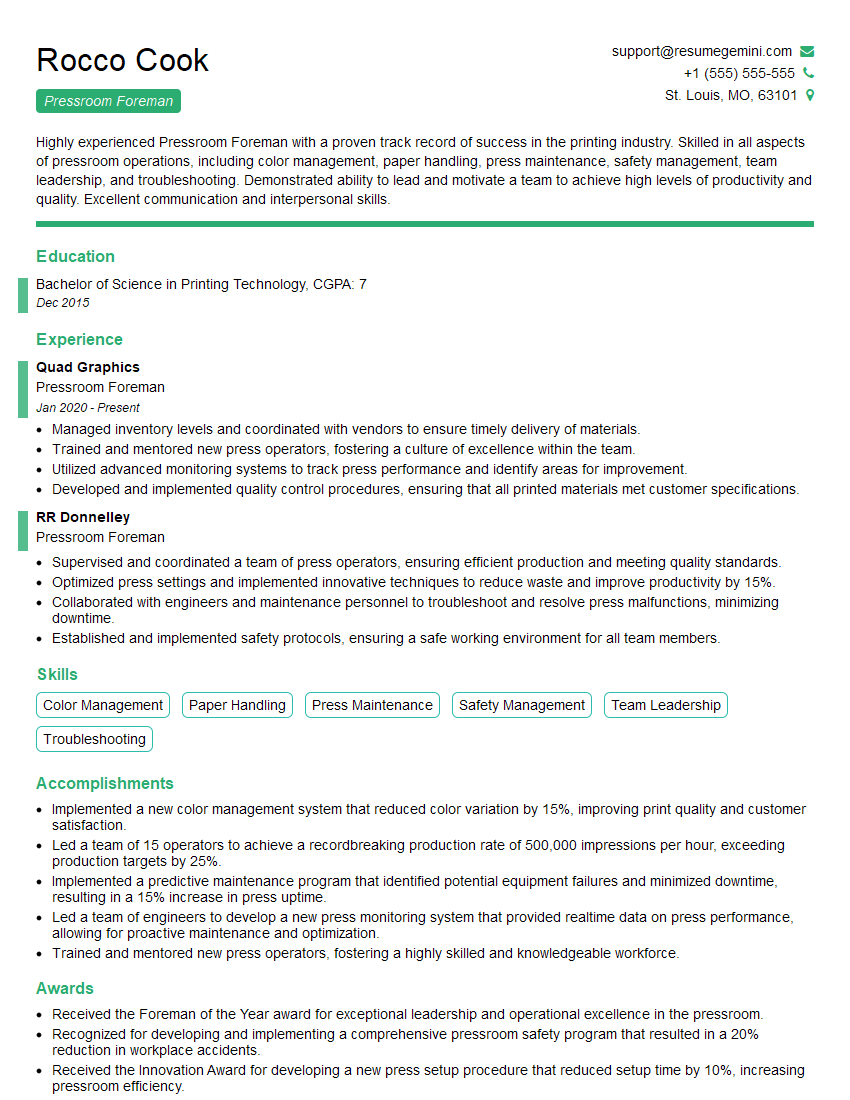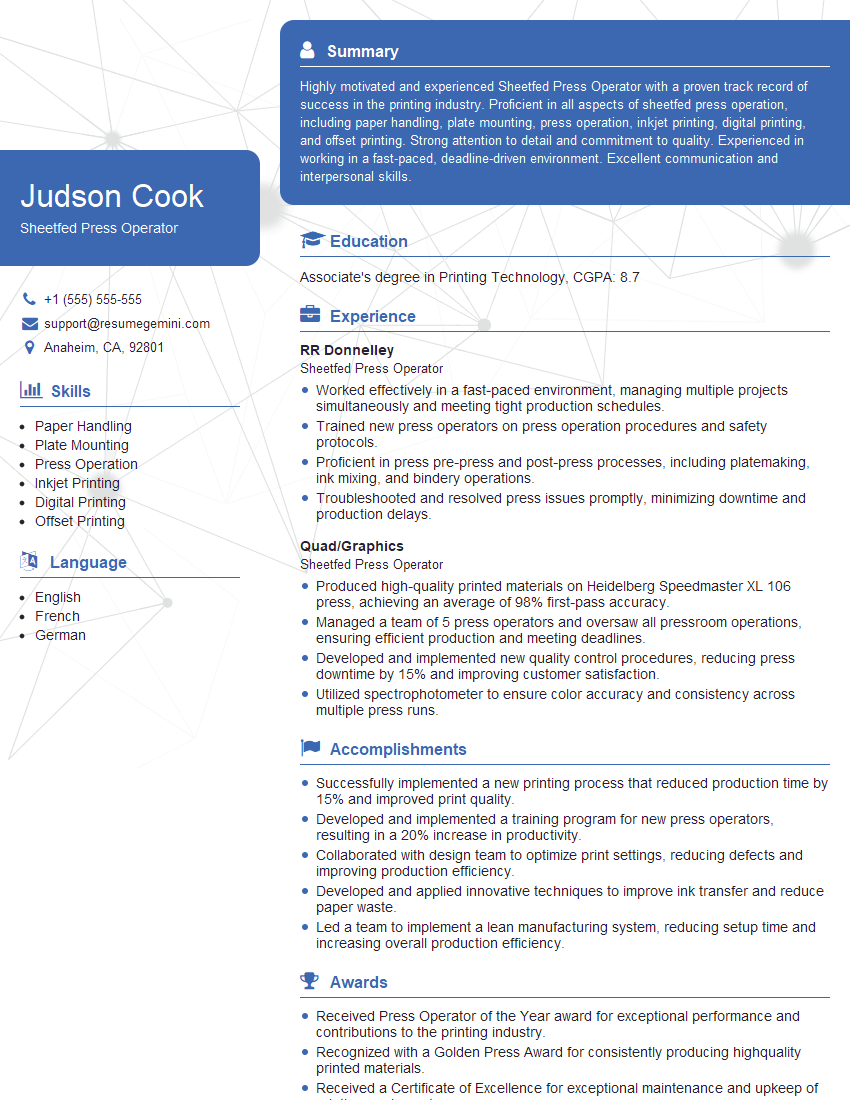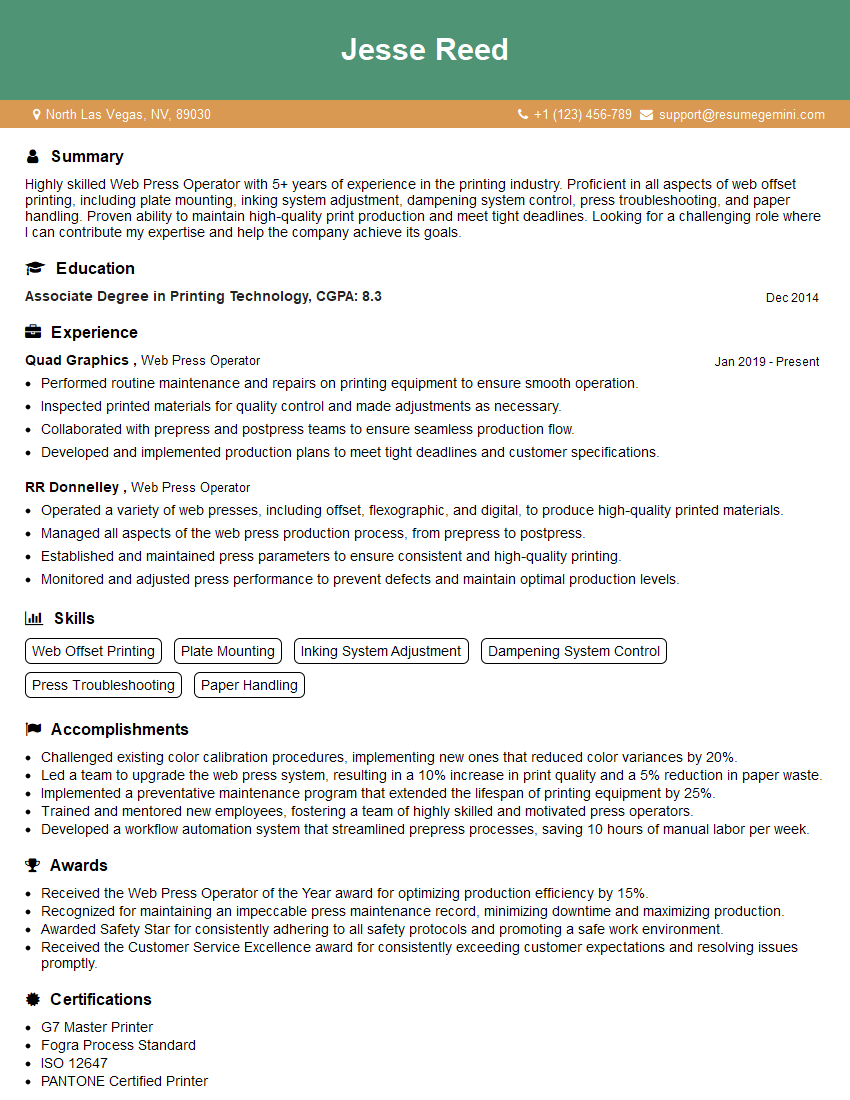Unlock your full potential by mastering the most common Knowledge of pressroom terminology interview questions. This blog offers a deep dive into the critical topics, ensuring you’re not only prepared to answer but to excel. With these insights, you’ll approach your interview with clarity and confidence.
Questions Asked in Knowledge of pressroom terminology Interview
Q 1. What is the difference between a sheetfed and a web press?
The core difference between sheetfed and web presses lies in how they handle paper. A sheetfed press feeds individual sheets of paper, one at a time, into the press. Think of it like a single-sheet document feeder on a printer. This is ideal for smaller print runs, high-quality work, and jobs requiring diverse paper stocks. Each sheet is precisely registered before printing. On the other hand, a web press uses a continuous roll of paper, similar to a roll of newspaper. This ‘web’ of paper moves through the press at high speeds, making it perfect for large-volume printing like newspapers, magazines, and mass-market brochures. The speed and continuous flow make web presses significantly faster but less flexible in terms of paper choices.
Imagine printing personalized greeting cards versus printing millions of flyers – sheetfed would be best for the cards, while web would suit the flyers.
Q 2. Explain the process of makeready on an offset press.
Makeready, in offset printing, is the crucial setup process before actual printing begins. It involves a series of precise steps to prepare the press for the specific job. This intricate process ensures accurate print registration, consistent ink distribution, and overall print quality.
- Plate mounting: The printing plates, carrying the image, are carefully mounted onto the plate cylinders.
- Blanket washing and preparation: The blankets (which transfer the ink from the plate to the paper) are thoroughly cleaned and conditioned.
- Ink and water setting: The precise balance of ink and dampening solution is established to achieve the desired image sharpness and density.
- Registration: A critical step where the plates and cylinders are aligned precisely to ensure that colors register accurately, preventing misalignment or blurring.
- Test prints: Several test prints are run to assess color balance, ink density, and overall print quality. Adjustments are made as needed before proceeding to the full run.
Think of makeready as a meticulous orchestra tuning process before a concert. Every instrument (cylinder, plate, ink) needs to be perfectly in tune to create a harmonious result.
Q 3. What are the common causes of hickies and how are they corrected?
Hickies are those pesky little blemishes – specks of dried ink or other foreign matter – that appear on a printed piece. They’re visually distracting and reduce print quality.
- Causes: Common causes include dust or lint in the press, dried ink particles, foreign objects in the ink, or even insects.
- Corrections: Addressing hickies involves a systematic approach. First, thoroughly clean the press. Inspect ink rollers, blankets, and plates for contamination. A thorough cleaning of the dampening system often helps. In some cases, changing the ink or using a high-quality ink filter might be necessary. Finally, if hickies persist, examine the paper for contaminants.
Finding the source can be like detective work, but carefully examining each component and implementing systematic cleaning usually resolves the problem.
Q 4. Describe the function of a blanket cylinder.
The blanket cylinder is a crucial component of an offset printing press. It’s a soft, rubber cylinder that acts as an intermediary between the printing plate and the paper. The plate cylinder first transfers the ink to the blanket cylinder. This cylinder then transfers the ink to the paper, creating the final print.
Its soft surface ensures even ink transfer, minimizing pressure marks on the paper. The blanket cylinder also helps to mitigate damage to the printing plate by absorbing the press’s pressure. Essentially, it’s the ‘go-between’ that protects both the plate and the paper, while ensuring the image is successfully transferred.
Q 5. What is the significance of maintaining proper ink-water balance?
Maintaining the proper ink-water balance is paramount in offset printing. It’s the delicate equilibrium between the ink and the dampening solution (water) applied to the printing plate. This balance directly impacts the quality of the final print.
- Too much water: Leads to muddy or dull colors, poor ink transfer, and potentially ink smearing.
- Too much ink: Results in excessively dark or heavy print, and can lead to ink piling up and clogging the rollers.
- Ideal Balance: Achieving the right balance results in sharp, vibrant colors, excellent dot reproduction, and a clean print overall.
Think of it as baking a cake; too much water makes it soggy, too much flour makes it dry. The perfect balance makes it delicious, just like a perfect ink-water balance creates a perfect print.
Q 6. How do you identify and address ghosting or slurring on a print?
Ghosting (also known as ‘double imaging’) appears as a faint, blurry shadow of the image next to the printed image. Slurring is the blurring or smearing of print along the edge of an image. Both significantly affect print quality.
- Identifying Causes: Ghosting can stem from issues like improper ink-water balance, worn rollers, or problems with the printing plates themselves. Slurring, on the other hand, is often caused by excessive ink, improper roller setting, or dirty blankets.
- Addressing Problems: To address these problems, carefully check the ink-water balance, assess the condition of rollers and blankets (cleaning or replacement might be necessary), inspect the printing plates for damage, and make sure the impression pressure is correctly set.
A systematic approach—inspecting every stage of the printing process—will generally reveal the culprit of ghosting or slurring. Sometimes, it may involve trial and error in adjusting settings to resolve these print defects.
Q 7. Explain the different types of printing plates used in offset printing.
Offset printing uses various types of plates to transfer the image onto the blanket cylinder. The choice depends on the print run length, print quality requirements, and budget.
- PS Plates (Photosensitive Plates): These are commonly used for shorter print runs. They’re relatively inexpensive but less durable than other types.
- CTP Plates (Computer-to-Plate): These are created directly from digital files, eliminating the need for film. They offer higher precision and efficiency, suitable for longer print runs and complex designs. CTP plates come in various types, including thermal plates and violet plates, each with its own properties and chemical sensitivities.
- Metal Plates: Though less common now due to advancements in CTP, these plates are created through a photographic process and are known for their durability.
Selecting the right plate is crucial for optimizing print quality and efficiency. It’s often a balancing act between cost and long-term performance for specific printing demands.
Q 8. What is the purpose of a dampening system in an offset press?
The dampening system in an offset press is crucial for controlling the ink-water balance on the printing plate. Think of it as a finely tuned faucet, regulating the amount of water applied to the plate. This is essential because offset printing relies on the principle of ‘hydrophilic’ (water-loving) and ‘hydrophobic’ (water-repelling) properties. The water wets the non-image areas of the plate (making them water-receptive and repelling ink), while the image areas (treated to be ink-receptive) attract the ink. An improperly balanced dampening system leads to problems like mottle (uneven ink distribution), or even complete ink rejection on the plate.
Dampening systems usually consist of several components, including rollers (form rollers, metering rollers, and dampening rollers), a fountain solution tank (containing the water and alcohol mixture), and various adjustments for controlling the water flow and distribution. The type of dampening system used can vary (e.g., conventional, alcohol-assisted, or fountain solution recycling systems), each with its own advantages and disadvantages in terms of efficiency, maintenance, and environmental impact.
Q 9. What are the various types of paper commonly used in the pressroom?
The choice of paper in the pressroom heavily influences print quality and the overall outcome. We use different types of paper depending on the application, whether it’s a glossy magazine cover or a sturdy cardboard box. Some commonly used types include:
- Coated Paper: This paper is coated with a layer of material (clay, calcium carbonate) to provide a smooth, glossy surface ideal for high-quality images and sharp text. Sub-types include matte, gloss, and silk coated papers, each with varying levels of gloss and absorbency.
- Uncoated Paper: This paper lacks the coating, offering a more natural, absorbent feel. It’s often preferred for applications where a more textured look is desired, or where ink absorption is important (e.g., business cards, letterheads).
- Newsprint: A low-cost, absorbent paper made from recycled fibers, commonly used for newspapers and flyers due to its low cost.
- Cardboard/Card Stock: Thicker and sturdier than regular paper, used for packaging and business cards requiring durability.
- Specialty Papers: This category includes papers with unique characteristics like textured surfaces, metallic finishes, or unusual colors. They are often used for premium marketing materials.
Q 10. Define the term ‘gripper margin’.
The gripper margin is the area of the paper sheet that’s gripped by the press’s grippers during the printing process. Imagine it as the ‘handle’ the press uses to hold and transport the paper through each printing unit. It’s crucial for ensuring accurate feeding and preventing misalignment. The gripper margin is usually located on the leading edge of the sheet (the edge that enters the press first) and is typically between 6mm and 12mm wide, depending on the press and the paper size. If the gripper margin is too small, the sheet may not be securely held, causing jams or misregistration. If it’s too large, it wastes paper.
Q 11. What are common pressroom safety procedures you must follow?
Pressroom safety is paramount. We always follow strict procedures, including:
- Lockout/Tagout: Before performing maintenance or repairs on any press equipment, we always implement a lockout/tagout procedure to prevent accidental startup.
- Personal Protective Equipment (PPE): We wear appropriate PPE, such as safety glasses, gloves, hearing protection, and steel-toe boots, to protect ourselves from potential hazards.
- Proper Lifting Techniques: Paper rolls and other heavy materials are handled using proper lifting techniques to avoid injuries.
- Fire Safety: We are familiar with the location of fire extinguishers and emergency exits. We regularly inspect the press for potential fire hazards.
- Chemical Handling: Ink and other chemicals are handled according to safety data sheets (SDS) to prevent accidents and exposure.
- Machine Awareness: We are always aware of the moving parts of the press and keep a safe distance during operation. We know how to stop the press quickly and safely in the case of emergency.
Q 12. How do you troubleshoot a press jam?
Troubleshooting a press jam requires a systematic approach. I always start by safely stopping the press and assessing the situation. Here’s a typical approach:
- Identify the location: Determine where the jam occurred (feeding, printing unit, delivery). Look for the obstruction.
- Remove the blockage: Carefully remove the jammed sheet or material, ensuring not to damage any press components. Never force anything.
- Check the paper path: Inspect the entire paper path for any obstructions or misalignment issues. Look for bent rollers or other problems.
- Check paper quality: Make sure that the paper is of proper quality and humidity. Damp or wrinkled paper is a common cause of jams.
- Check grippers: Ensure that the grippers are clean and functioning correctly. Worn or damaged grippers often cause misfeeding issues.
- Adjust settings (if needed): Sometimes, the jam may indicate a need for adjustments to the paper feed or other press settings. I consult the press operating manual for guidelines.
- Restart the press: Once the issue is resolved and the paper path is clear, slowly restart the press and monitor the operation.
If the problem persists, I would consult with experienced press operators or maintenance personnel.
Q 13. Explain the concept of color registration.
Color registration, in offset printing, refers to the precise alignment of different color inks on a printed sheet. Imagine printing a four-color image (CMYK). Each color (Cyan, Magenta, Yellow, and Black) is printed separately, and it’s critical that they align perfectly to create the final, intended image. If the colors aren’t perfectly registered, you’ll see misaligned colors, resulting in blurry images and a loss of detail. This is similar to how multiple layers of a photograph must align precisely for the final image to be sharp.
Achieving accurate color registration involves careful adjustments to the press settings during the setup process and ongoing monitoring throughout the print run. Factors like paper stretch, temperature, and humidity all affect registration, so it’s a process that requires careful attention to detail.
Q 14. What is the significance of maintaining the correct printing pressure?
Maintaining the correct printing pressure is essential for achieving high-quality prints and avoiding print defects. Printing pressure is the force applied to the printing plate to transfer ink to the paper. If the pressure is too low, the ink transfer will be incomplete, resulting in light, faint prints or even missing areas. If the pressure is too high, you’ll risk damaging the plate and the paper, creating unwanted marks or smudges on the print, and increasing wear and tear on the press components. The optimal printing pressure depends on several factors, including the type of plate, paper, ink, and the desired print quality.
Think of it like baking: you need the right amount of pressure to bake a perfect cake. Too little, and it’s undercooked; too much, and it’s burnt. Similarly, the right printing pressure ensures that the ink is transferred uniformly and efficiently, resulting in sharp, clear prints. Incorrect printing pressure also leads to faster wear of printing plates and rollers.
Q 15. What is the role of a spectrophotometer in quality control?
A spectrophotometer is an indispensable tool in pressroom quality control. It’s a device that measures the color of an object by measuring the wavelengths of light reflected, transmitted, or absorbed by it. In printing, this translates to precisely measuring the color of printed samples to ensure they match the approved design. Think of it as a highly accurate color ‘scale’ – it provides numerical data representing the color, allowing for objective comparison against the target color specifications.
Its role is crucial because human eyes can be subjective and unreliable in judging subtle color differences. The spectrophotometer eliminates this subjectivity, providing objective data to verify if the printed colors meet the required standards. This is particularly vital in tasks like ensuring consistent color across large print runs, verifying color accuracy against Pantone references, or detecting and correcting color variations introduced by different printing conditions (paper type, ink density, etc.). For example, a spectrophotometer can detect a slight shift in cyan in a large poster print that the naked eye might miss, allowing for timely adjustments to the printing process before a large number of incorrect copies are produced.
Career Expert Tips:
- Ace those interviews! Prepare effectively by reviewing the Top 50 Most Common Interview Questions on ResumeGemini.
- Navigate your job search with confidence! Explore a wide range of Career Tips on ResumeGemini. Learn about common challenges and recommendations to overcome them.
- Craft the perfect resume! Master the Art of Resume Writing with ResumeGemini’s guide. Showcase your unique qualifications and achievements effectively.
- Don’t miss out on holiday savings! Build your dream resume with ResumeGemini’s ATS optimized templates.
Q 16. How do you calculate the number of impressions per hour?
Calculating impressions per hour (IPH) is fundamental in evaluating press productivity. It’s a simple calculation, but requires accurate data collection. The formula is:
IPH = (Number of sheets printed per hour) * (Number of impressions per sheet)For example, if a press prints 10,000 sheets per hour and each sheet has four color impressions (four-color process), then the IPH is 40,000. However, this calculation needs adjustments based on the press’s downtime during the hour (for instance, for cleaning, paper changes, or machine adjustments). The true IPH would be the total impressions achieved during the hour, taking into account these unavoidable stoppages. Efficient scheduling and minimizing downtime are critical to achieving high IPH and optimal productivity. In practice, one would track the actual number of sheets printed during a one hour period and apply the formula accordingly to avoid overestimating capacity.
Q 17. What are the different types of inks used in printing?
The printing industry uses a variety of inks, each suited to different printing methods and desired outcomes. Some common types include:
- Process Inks (CMYK): Cyan, Magenta, Yellow, and Key (black). These are the foundation of four-color process printing, used to reproduce a wide range of colors by mixing these four base colors. This is the most common method for mass-production.
- Pantone Matching System (PMS) Inks: These are spot colors, each with a specific formula for a precise color. They provide greater color accuracy and consistency compared to CMYK, especially for critical colors that must be matched exactly across different print jobs. They are generally used for high-impact applications where precise color is essential.
- Metallic Inks: These create shimmering effects of gold, silver, copper, etc. They often require specialized printing processes.
- UV Inks: These are cured (dried) using ultraviolet light. They offer quick drying times, high gloss, and scratch resistance.
- Water-Based Inks: These are more environmentally friendly options, often used in packaging or other applications where minimizing environmental impact is important.
The choice of ink depends greatly on the project’s requirements, budget, and intended audience.
Q 18. Explain the differences between PMS and CMYK colors.
PMS and CMYK represent fundamentally different approaches to color reproduction. CMYK (Cyan, Magenta, Yellow, and Key/Black) is a subtractive color model. It works by mixing colored pigments to create the final color on the printed piece. Imagine mixing paints; each additional color subtracts light. PMS (Pantone Matching System) is a spot color system, assigning a unique color formula to each Pantone color number. This formula remains consistent regardless of the printer or printing process.
The key difference lies in accuracy and consistency. CMYK, while offering a wide gamut of colors, can result in slight variations depending on the printer, ink type, and paper used. PMS colors, on the other hand, are precisely defined and are intended to stay highly consistent across different applications. PMS is ideal for situations demanding perfect color matching (like a corporate logo), while CMYK suits applications needing a wide range of colors without the need for perfect consistency across different print runs. One might use PMS for a company logo and CMYK for a full-color photograph on the same print job.
Q 19. What are some common printing defects and their causes?
Printing defects can range from minor flaws to major issues that necessitate job rejection. Here are some common examples and their causes:
- Color Variations: Inconsistent ink density, incorrect ink mixing, or variations in substrate absorption can cause color inconsistencies throughout the print.
- Mottle: Uneven ink distribution, leading to a speckled appearance. This can be due to issues with the ink, the rollers, or the printing pressure.
- Hickeys: Small spots of foreign material (e.g., dust) embedded in the printed image. These need careful cleaning to avoid repeating defects.
- Streaking: Uneven ink lay-down, often due to problems with the ink fountain, rollers, or printing pressure.
- Set-off: The wet ink from one sheet transferring to the next. This usually happens with high-speed printing and inks that take longer to dry.
- Ghosting: Faint image from the back of a sheet showing through, particularly with lightweight or translucent materials.
Troubleshooting these defects often involves a careful investigation of the entire printing process, from the preparation of printing plates to the overall press settings and ink characteristics.
Q 20. Describe the process of cleaning and maintaining printing plates.
Cleaning and maintaining printing plates is critical to maintaining print quality and preventing defects. The process depends largely on the type of plate (e.g., aluminum, polymer) and the ink used. Generally, the steps involve:
- Inspection: Examine the plate for any visible damage, debris, or residual ink.
- Initial Cleaning: Use a plate cleaning solution (often solvent-based for specific types of inks, or water-based for environmentally friendly approaches) and a soft cloth or brush to remove the bulk of the ink. Careful wiping prevents scratches.
- Deep Cleaning: For stubborn ink residues, an ultrasonic cleaning bath might be necessary. This uses sonic waves to dislodge ingrained ink particles.
- Drying: Allow the plate to air dry completely before storing. Moisture can cause corrosion and damage.
- Storage: Store plates in a clean, dry, and protected environment to prevent scratching or damage.
Regular cleaning extends the plate’s lifespan and prevents issues like clogged ink channels, ultimately leading to more consistent and higher-quality printing.
Q 21. What is the purpose of a fountain solution?
Fountain solution, also known as dampening solution, plays a crucial role in offset lithography. It’s a mixture of water and additives applied to the printing plate to maintain a balance of hydrophilicity (water-loving) and lipophilicity (ink-loving) properties. This balance is essential because offset lithography relies on the principle of repelling water and attracting ink to achieve the desired image transfer.
The fountain solution’s purpose is to keep the non-image areas of the plate wet, preventing ink from adhering. This is vital for achieving clean, crisp, and accurate images without smearing or unwanted ink. The exact composition and pH of the fountain solution can vary depending on the type of paper, ink, and printing press. Incorrect fountain solution can lead to problems like scumming (ink on non-image areas) or poor ink transfer, compromising print quality. Proper maintenance of the fountain solution, monitoring its pH, and regular changes are key to achieving optimal printing results.
Q 22. Explain the role of a feeder in a printing press.
The feeder is the unsung hero of the printing process, responsible for accurately and consistently feeding individual sheets of paper or other substrates into the printing press. Think of it as the press’s highly skilled and tireless assistant. It ensures that each sheet is properly aligned and positioned before it reaches the printing units, preventing misfeeds and maintaining print quality.
Different feeders exist depending on the press type and substrate. Sheet-fed presses, common for larger format printing, use complex mechanisms involving suction cups, rollers, and sophisticated sensors to gently but firmly pull sheets from the stack. These sensors monitor paper thickness and detect any jams or misalignments, immediately halting the process to prevent damage or errors. Roll-fed presses, often used for continuous printing like newspapers, employ unwind stands and sophisticated tension control systems to ensure a consistent feed of the paper roll.
Without a properly functioning feeder, the printing process would grind to a halt. Misfeeds lead to wasted paper, ink, and time, significantly impacting productivity and profitability.
Q 23. What is the difference between a perfect binder and a saddle stitch?
Perfect binding and saddle stitching are two common bookbinding techniques, each best suited for different types of publications. Imagine you’re building a house – one method is for a large, sturdy structure, the other for something smaller and simpler.
Perfect binding involves gluing the edges of the pages together to create a flat spine. Think of softcover books like paperbacks or notebooks. This method allows for a larger number of pages and a flatter spine, ideal for textbooks or novels. The pages are trimmed to create a square edge before being glued. This method often includes a cover that is wrapped around the glued block of pages.
Saddle stitching, on the other hand, involves folding sheets of paper in half and securing them with wire staples along the spine. Think of magazines or brochures. It’s a simpler, faster, and cheaper method, typically used for documents with a lower page count, where a flatter spine isn’t crucial. It’s quick and economical, making it perfect for smaller projects.
Q 24. What is the impact of paper moisture content on printing quality?
Paper moisture content significantly impacts print quality. Think of it as the perfect recipe – if you use the wrong amount of an ingredient, the result can be disastrous. Paper that is too dry can lead to static cling, causing sheets to stick together or misfeed in the press. This also increases the risk of paper cracking or tearing, especially in high-speed production. It can also lead to increased ink absorption and potential for smudging.
Conversely, paper that is too moist can result in sheet distortion, causing registration issues (the alignment of multiple colors) and poor print quality. It may also lead to increased drying time, slower production rates, and even ink bleeding. The ideal moisture content is crucial for consistent and high-quality printing.
Proper climate control in the pressroom, monitoring humidity and temperature, is essential to maintain the optimal moisture content of paper and ensure consistent printing.
Q 25. How do you manage waste in the pressroom?
Waste management in the pressroom is crucial for environmental responsibility and cost-effectiveness. It’s about reducing, reusing, and recycling, all while improving efficiency. A well-organized waste management strategy is a cornerstone of a successful pressroom. We employ several strategies:
- Minimizing waste: Careful job planning, accurate color calibration, and efficient material handling help minimize paper waste through optimized cutting and reduced misfeeds. We also carefully monitor and address any press malfunctions to prevent excessive scrap.
- Recycling: We segregate waste materials such as paper, cardboard, and plastic into different streams for appropriate recycling. Partnering with a reputable recycling facility is key.
- Reusing: Usable scraps may be repurposed for smaller jobs or internal use, reducing waste. We track ink usage meticulously and reuse any remaining ink from a completed job where possible.
- Tracking and analysis: Regular monitoring of waste generation helps identify trends and pinpoint areas for improvement. Data analysis helps us make informed decisions about process optimization and waste reduction.
A lean, green approach to waste management improves our bottom line and environmental impact.
Q 26. Explain the importance of maintaining proper temperature and humidity.
Maintaining proper temperature and humidity in the pressroom is vital for consistent print quality and efficient production. Think of it as creating the ideal environment for the ‘ingredients’ in your printing process. It directly affects the paper’s moisture content, as discussed earlier, influencing its dimensional stability and preventing static electricity issues.
Temperature affects the viscosity (thickness) of ink, impacting color consistency and dot gain. Too high a temperature could lead to faster ink drying but also cause the ink to become too thick and difficult to transfer correctly. Too low a temperature might cause slower drying and smudging.
Humidity, as we’ve noted, is crucial for controlling paper moisture content and reducing static electricity, preventing paper jams and misfeeds. It also affects the ink’s drying process.
Climate control systems, ideally with temperature and humidity monitoring and control, are essential for maintaining the optimal conditions, ensuring consistent output and reduced downtime caused by printing-related issues.
Q 27. Describe the process of setting up a new job on the press.
Setting up a new job on the press is a meticulous process involving several steps, akin to preparing for a complex surgical procedure. Accuracy and precision are paramount to avoid errors and waste.
- Pre-press checks: Verify all aspects of the job from artwork to paper selection. Ensure all files are correct and the necessary materials are available.
- Plate mounting: Carefully mount the printing plates onto the press cylinders, ensuring accurate registration (alignment). This step involves precise alignment of the plates in order to produce accurate color reproduction and positioning of the image on the page.
- Ink and roller setup: Adjust the ink supply to achieve the desired color and density. Correct roller settings are crucial for even ink distribution. We use color charts and test prints to ensure quality.
- Paper setup: Configure the feeder and paper path according to the paper type and size. We verify settings to avoid misfeeds.
- Press test: Run a test print to check for issues with registration, color accuracy, and overall print quality. Adjust settings as needed to optimize the final print.
- Production run: Once the test prints are approved, the main production run begins. Continuous monitoring is crucial to ensure consistent quality throughout the run.
Each step requires expertise and attention to detail. It’s a dance of precision that ensures a high-quality final product.
Q 28. What are the different types of drying systems used in printing?
Drying systems in printing are crucial for ensuring that the ink adheres properly to the substrate and doesn’t smudge or offset (transfer to other sheets). Different systems cater to various printing methods and ink types.
- Air drying: This is the simplest method, relying on natural air circulation to evaporate the solvent or water from the ink. While suitable for small jobs or certain inks, it’s slow and less effective for high-speed printing or inks requiring faster drying.
- Infrared (IR) drying: IR dryers use heat lamps to quickly evaporate the solvents, making them suitable for higher speeds. They are widely used in many printing processes. It is important to choose the correct wavelength to maximize efficiency and reduce substrate damage.
- Ultraviolet (UV) drying: UV drying uses UV light to instantly cure UV inks, eliminating drying time altogether. This is particularly useful for packaging and applications where quick turnaround is necessary. UV inks are known for their bright colors and exceptional durability.
- Hot air drying: Uses heated air blown across the printed substrate to accelerate drying. This method provides greater control of temperature and air velocity compared to air drying alone. The system’s design is crucial to avoid overheating or uneven drying.
The choice of drying system depends on factors such as ink type, printing speed, substrate, and the required level of drying.
Key Topics to Learn for Knowledge of Pressroom Terminology Interview
- Press Types & Operations: Understanding the differences between offset, digital, and flexographic printing processes; familiarization with common press models and their capabilities; knowledge of makeready procedures.
- Color Management & Calibration: Practical application of color profiles (e.g., CMYK, Pantone); troubleshooting color inconsistencies; experience with spectrophotometers and densitometers.
- Paper Handling & Stock: Identifying various paper types and their properties; understanding paper feeding mechanisms; troubleshooting paper jams and misfeeds; knowledge of paper weight and grain direction.
- Ink & Coating Systems: Understanding different ink types (e.g., UV, water-based, solvent-based); knowledge of ink viscosity and adjustments; experience with coating units and their functions.
- Pressroom Safety & Maintenance: Familiarization with safety protocols and procedures; basic understanding of press maintenance and troubleshooting; knowledge of common pressroom hazards and preventative measures.
- Print Quality Control: Identifying and addressing print defects (e.g., dot gain, mottle, slur); understanding print specifications and tolerances; experience with quality control checks and documentation.
- Prepress & Workflow: Understanding the relationship between prepress and pressroom operations; familiarity with file formats and proofing methods; knowledge of workflow optimization techniques.
Next Steps
Mastering pressroom terminology is crucial for career advancement in the printing industry. A strong understanding of these concepts demonstrates your expertise and opens doors to more challenging and rewarding roles. To maximize your job prospects, focus on building an ATS-friendly resume that highlights your skills and experience effectively. ResumeGemini is a trusted resource to help you craft a compelling resume that showcases your qualifications. We provide examples of resumes tailored to Knowledge of pressroom terminology to guide you in creating a professional and impactful document. Take the next step towards your dream job today!
Explore more articles
Users Rating of Our Blogs
Share Your Experience
We value your feedback! Please rate our content and share your thoughts (optional).



